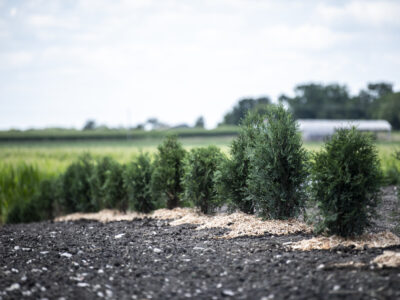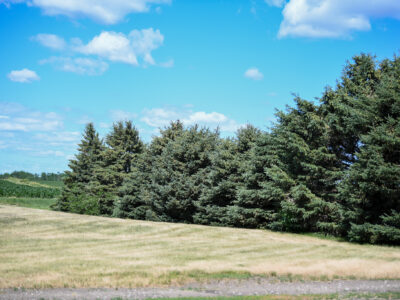Why should I plant trees?
There are many reasons to plant trees – from snow control to wind protection to improving relationships with neighbors. Although there will be an up-front cost, have you considered the ways a properly-designed tree planting could pay for itself? If you don’t have to scoop snow out of feed bunks, off pit fans or a roof, trees pay for themselves quickly!
Additionally, trees can provide visual screening, reduce odor and improve relationships with neighbors. The cost of establishing trees is much cheaper than defending yourself in a nuisance lawsuit.
What type of trees should I plant? When should I plant them?
The type of trees you should plant depends on what you want to accomplish with a planting. The first step is to determine what you want the trees to do. If you want visual screening, you may want to consider a hybrid willow (or austree). They are a very cost-effective and fast growing tree and provide more immediate results. If you want to improve aesthetics and/or neighbor relations, consider additional ornamental trees and flowering shrubs in highly visible areas. For snow control and wind protection, think about evergreens. With a properly designed plan, the hybrid willow also can provide very effective snow and wind protection. If you have room, a multi-row, multi-species planting is an option.
The key to success is having the right plan in place from the beginning. The last thing you want to do is plant trees and/or shrubs in the wrong place, have them cause unintended negative consequences and have to rip them out in ten years.
The best time of year to plant is spring or fall – the two busiest seasons for farmers! The good news is there are several nursery professionals who offer services to make it easy for you!
Where should I plant trees? How far back do they need to be from my barn?
On the north and west sides of a livestock or poultry barn or feedlot, we typically recommend keeping trees 70-100 feet back. That distance allows for adequate airflow and provides room for snow drop (if there is going to be any – it all depends on the density of your tree planting). On farms with minimal room to work with, we have seen trees planted closer. Tunnel-ventilated sites are usually less sensitive to the distance recommendations than naturally-ventilated facilities.
Most summer breezes come from the south or southeast in Iowa. As a general rule of thumb, dense tree plantings on the south and east sides should be avoided for naturally-ventilated barns. However, a few strategically placed ornamental trees and flowering bushes for aesthetic purposes may work well on these sides (especially farms with unhappy neighbors).
Will trees negatively impact ventilation and airflow?
If planted in the right place with the proper spacing, no. If planted in the wrong place, yes, trees could negatively impact airflow. On naturally-ventilated barns, avoid planting dense trees on the south and east sides. The expert nursery professionals participating in the Green Farmstead Partner program (GFP) have experience designing plantings that won’t cause negative air flow or snow deposition impacts.
In some cases, trees may actually improve ventilation. Yes, you read that correctly, we’ve seen cases where trees can improve ventilation! How so? If a strong wind hits the tunnel fans head-on, they oftentimes struggle to keep the barn adequately ventilated. In a situation like this, a line of trees would protect those tunnel fans, and in doing so, improve ventilation in the building while reducing energy costs.
How much work are trees going to be?
The amount of time and labor you will need to put into tree maintenance depends on how the trees are planted. If you plant seedlings or smaller nursery stock, the up-front cost will be less. However, you may spend more time maintaining and replacing plants than you would with larger plants. You will also need to decide if you want to do the planting yourself or hire a nursery professional. If you plant yourself, be sure to properly prepare the ground to reduce compaction.
A new planting will need watering – the rule of thumb is 1-inch of water every 7 to 10 days, including rainfall. We have nursery professionals participating in the Green Farmstead Partner program who can install automatic irrigation systems, which can provide significant time savings (especially in low rainfall years).
How expensive will a tree planting be?
The up-front cost is highly variable, depending on how extensive the plan is, the size of trees you plant, and if you plant yourself or hire someone. Smaller, bare root plants will typically have a lower initial cost than larger, potted plants, but usually will then require more maintenance and will take longer to mature. Any of the nurseries participating in the GFP program can give you a cost estimate specific to your farm. For a complete list of nurseries and their contact information, please visit www.supportfarmers.com/nurseries.
Is there cost-share available?
By working through the Green Farmstead Partner program, the cost of your initial consultation and plan design from a participating nursery is covered by the Coalition to Support Iowa’s Farmers. Beyond that, the GFP program and partners do not offer cost-share dollars for trees and shrubs. However, there are numerous environmental-enhancement programs which may provide cost-share funds for tree plantings on your farm. Program rules and regulations vary, so you should carefully check to see if your plans will qualify.
Cost-share programs you may want to consider include:
- Conservation Reserve Program (CRP)
- Wildlife Habitat Incentive Program (WHIP)
- Environmental Quality Incentives Program (EQIP)
- Resource Enhancement and Protection (REAP)
- Trees Forever Working Watersheds—Buffers and Beyond Program
What exactly is the Green Farmstead Partner program?
The Green Farmstead Partner program was created to bridge the gap between farm families who want to plant trees and the nursery professionals who have expertise in tree plantings on farms and in rural areas. It is offered by the Coalition to Support Iowa’s Farmers with the help of Trees Forever and the Iowa Nursery and Landscape Association. The program provides information on tree and shrub plantings for livestock farms and offers the expertise of nineteen nursery professionals around the state. In other words, it is here to help you determine what you want from a tree planting, figure out how to accomplish it and get it in the ground and growing!
How do I get started?
The best place to begin is to personally assess your farm, determine your goals and develop a timeline of when you want to start and complete the project. The Coalition is here to help you through the process, answer questions and would be happy to come to your farm, at no charge, for a personal consultation. You can reach the Coalition at 1-800-932-2436.
The next step is to contact a nursery and landscape professional to discuss your needs, wants and options. Be sure to visit www.supportfarmers.com/nurseries for a list of experts who have completed training with the Coalition—they will be able to design a plan for a vegetative buffer on your farm.
Once your planting is complete, you may qualify for a personalized Green Farmstead Partner program sign to display at the farm.



